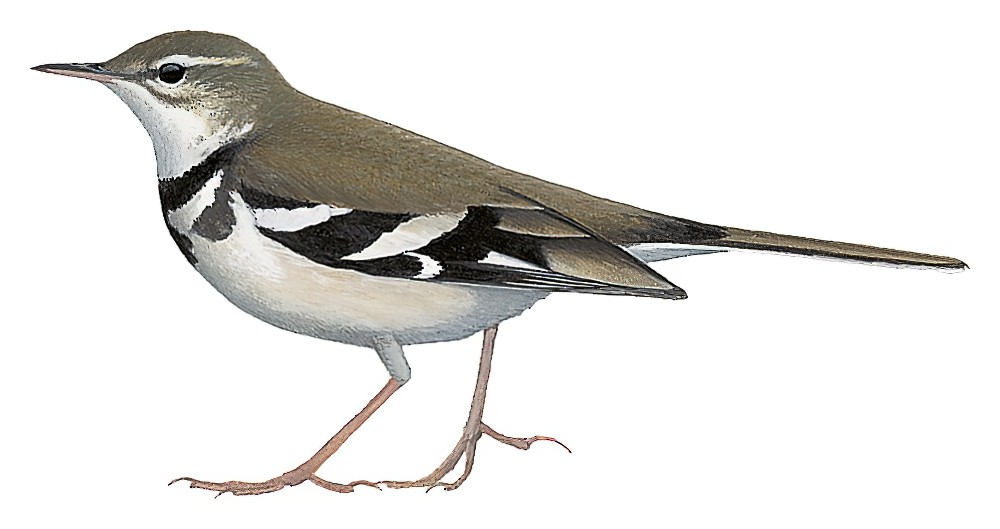Forest Wagtail / Dendronanthus indicus

Forest Wagtail
SCI Name:
Protonym: Motacilla indica Syst.Nat. 1 pt2 p.962
Taxonomy: Passeriformes / Motacillidae / Dendronanthus
Taxonomy Code: forwag1
Type Locality: India.
Author: Gmelin, JF
Publish Year: 1789
IUCN Status: Least Concern
DEFINITIONS
DENDRONANTHUS
(Motacillidae; † Forest Wagtail D. indicus) Gr. δενδρον dendron tree; genus Anthus Bechstein, 1805, pipit; "130. Dendronanthus (nobis) indicus; Motacilla indica, Gm. M. variegata, Vieillot, not of Latham. I have just obtained a beautiful specimen of this bird." (Blyth 1844); "Dendronanthus Blyth, 1844, Annals and Magazine of Natural History, XIII, p. 116. Type by monotypy, Motacilla indica Gmelin, 1789." (JAJ 2020).
Var. Dendranthus.
Synon. Budytanthus, Limonidromus, Nemoricola, Nemorivaga.
• (Motacillidae; syn. Anthus † Tree Pipit A. trivialis) "The Tree Pipits (to which, if it be thought necessary to separate them, the name Dendronanthus may be applied), are distinguished by shorter tarsi, a less elongated and more curved hind-claw, and a comparatively short and less slender bill than in many others: they resort to open woodlands, and perch often; and their gait and general manners are different from those of other Pipits (as may be well observed by keeping them in confinement). Their actions are more deliberate, and they have not the habitual rapid run of other Pipits and Wagtails; neither, in captivity, are they at all peckish and quarrelsomely disposed towards their companions ... 1. A. trivialis, (L.): A. arboreus, Bechstein. ... 2. A. Richardi, Vieillot." (Blyth 1847); "Dendronanthus Blyth, 1847, Journal Asiatic Soc. Bengal, XVI (I), p. 432 (not of Blyth, 1844). Type, by subsequent designation (G. Gray, 1855, Cat. Genera Subgenera Birds Brit. Mus., p. 40), Alauda trivialis Linnaeus, 1758." (JAJ 2021).
indicus
L. Indicus Indian < India India. In early ornithology the term Indiis was also applied to the East Indies and, less frequently, to the West Indies and the Guianas.
● India and Tibet; ex “Barred-headed Goose” of Latham 1787 (Anser).
● Erroneous TL. India (= South Carolina) (syn. Baeolophus bicolor).
● Java; ex “Javan Hawk” of Latham 1781 (Butastur).
● ex “Indian Goatsucker” of Latham 1787 (Caprimulgus).
● ex “Drongolon” of Levaillant 1805, pl. 174, and “Long-tailed Shrike” of Latham 1822 (syn. Dicrurus macrocercus).
● ex "Psittaca indica coccinea” of Brisson, “Perruche des Indes orientales” of d’Aubenton 1765-1781, pl. 143, “Lori Perruche violet et rouge” of de Buffon 1770-1783, and “Indian Lory” of Latham 1781 (syn. Eos histrio).
● ex “Lohaujung Heron” of Latham 1787 (syn. Ephippiorhynchus asiaticus).
● ex “Eastern black Cuckow” of Lastham 1787 (syn. Eudynamys scolopaceus).
● ex “Grand Vautour des Indes” of Sonnerat 1782 (Gyps).
● ex “Indian Curucui” of Latham 1787 (?syn. Harpactes fasciatus).
● ex “Merle des Indes orientales” of d’Aubenton 1765-1781, pl. 273, fig. 2 (syn. Lalage nigra).
● ex “Smallest red and green Indian Paroquet” of Edwards 1743-1751, “Psittacula indica” of Brisson 1760, and “Red and green indian Parrot” of Latham 1781 (syn. Loriculus beryllinus).
● ex “Indian Jacana” of Latham 1787 (Metopidius).
● ex “Little Hawk Owl of Ceylon” of Pennant 1769, and “Indian Eared Owl” of Latham 1781 (syn. Otus bakkamoena).
● ex “Gélinote des Indes” of Sonnerat 1776, and “Indian Grous” of Latham 1783 (Pterocles).
● ex “White-chinned Bustard” of Latham 1783, and “Passarage Bustard” of Latham 1787 (Sypheotides).
● ex “Rossignol de muraille des Indes” of Sonnerat 1782 (Tarsiger).
● ex “Bécassine blanche des Indes” of Sonnerat 1776, and “White indian Snipe” of Latham 1785 (?Tringa erythropus).
● Erroneous TL. India (= Gamtoos River, Cape Province, South Africa); ex “Indian Coly” of Latham 1787 (Urocolius).
● ex “Vanneau armé des Indes” of de Buffon 1770-1785 (Vanellus).
● ex “Little redwinged Parrakeet” of Edwards 1758-1764, and “Psittaca indica” of Brisson 1760 (unident.).
● India; ex “Sicrin” of Levaillant 1801, pl. 82 (artefact).
UPPERCASE: current genus
Uppercase first letter: generic synonym
● and ● See: generic homonyms
lowercase: species and subspecies
●: early names, variants, mispellings
‡: extinct
†: type species
Gr.: ancient Greek
L.: Latin
<: derived from
syn: synonym of
/: separates historical and modern geographic names
ex: based on
TL: type locality
OD: original diagnosis (genus) or original description (species)












